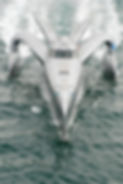Boats That Defy Physics - One Flies, One Flips
- BoatBlurb Contributor
- Aug 13
- 4 min read
By: Koushik Paul
If you think boats are bound by traditional rules of the sea, think again. In the world of extreme marine engineering, a vessel’s worth isn’t judged only by how fast it sails or how much cargo it carries, but by how far it dares to stray from convention. Today, we’ll look at two very different boats that each rewrote the script in their own way: Earthrace, a trimaran that circled the globe at record speed powered entirely by biodiesel, and R/P FLIP, a research vessel that flips upright like a floating skyscraper.
Both vessels embody the mantra that extreme function demands extreme form. Yet their stories couldn’t be more different.
Earthrace / Ady Gil -- The Flying Trimaran with a Green Heart

In 2006, New Zealand skipper Pete Bethune set out to do something no one had tried before—race a powerboat around the globe faster than anyone in history, without burning a drop of fossil fuel.
The boat that emerged from that vision was Earthrace, a 78-foot, wave-piercing trimaran that looked more like a futuristic fighter jet than a conventional powerboat. The hull, designed by LOMOcean in Auckland, was a marvel of carbon fibre and Kevlar composites. The goal was to reduce drag and improve seaworthiness by allowing the bow to slice through waves rather than ride over them, even if it meant plunging several metres beneath the surface in heavy seas. That choice alone was a departure from almost every other high-speed boat design.
Power came from twin 540-horsepower Cummins MerCruiser diesel engines, but with a twist — they ran exclusively on biodiesel made from animal fats and vegetable oils. Bethune insisted on renewable fuel, even rejecting a $4 million sponsorship offer that would have required switching to petroleum diesel. His dedication to sustainability extended to the rest of the build: hemp composites, non-toxic paints, and a zero-carbon-footprint voyage plan.
The first circumnavigation attempt in 2007 ended in heartbreak. After battling monsoon storms, mechanical failures, and even a collision with a fishing vessel off Guatemala, the team was forced to abandon the run. But Bethune wasn’t done. In April 2008, Earthrace set off again, completing the 23,497-nautical-mile journey in 60 days, 23 hours, and 49 minutes—smashing the previous record by over 13 days.
Earthrace became a celebrity in its own right, touring more than 180 ports and drawing hundreds of thousands of visitors. In 2009, it was acquired by the Sea Shepherd Conservation Society, renamed the Ady Gil, and sent to Antarctica to intercept Japanese whaling ships. The trimaran’s speed and stealth made it a perfect pursuit craft — until January 2010, when it collided with the whaler Shōnan Maru No. 2. The bow was sheared off, and despite attempts to tow it to safety, Ady Gil sank in the frigid Southern Ocean.
Bethune later reflected that the boat had fulfilled its mission, both in proving the viability of biodiesel in extreme conditions and its challenging perceptions of what high-performance marine design could be.
R/P FLIP -- The Floating Skyscraper of Ocean Science
Where Earthrace was built to move, R/P FLIP was built to stand still. Commissioned in 1962 by the Scripps Institution of Oceanography and the U.S. Office of Naval Research, this 355-foot vessel has one party trick: it can rotate 90 degrees so that its stern plunges into the ocean and only its bow remains above water.
The transformation takes about 30 minutes. Seawater floods massive ballast tanks, causing the stern to sink until FLIP is almost entirely vertical, with roughly 300 feet submerged and 55 feet exposed. In this mode, the vessel becomes extraordinarily stable — wave motion at the bow might be reduced to mere inches, even in rough seas. This stability is exactly what oceanographers need when measuring delicate variables like sound propagation, wave patterns, and atmospheric interaction. For decades, FLIP served as a floating lab for research into sonar technology, marine mammal communication, and climate science. Its tall, narrow profile in vertical mode earned it the nickname “the floating pencil” among crews.
Inside, FLIP is as unusual as its silhouette. In vertical mode, beds are mounted on swivels, sinks have drains in both ends, and toilets pivot to remain level. The galley and workstations are designed to function equally well whether the vessel is horizontal or upright.
By 2017, FLIP’s working life had slowed, and in 2023, escalating maintenance costs led to its official decommissioning. It seemed destined for the scrapyard. But in early 2024, subsea engineering company DEEP acquired FLIP and announced a complete refit in La Ciotat, France. The 12- to 18-month overhaul aims to upgrade its systems, enhance habitability, and adapt it for a new era of ocean research.













